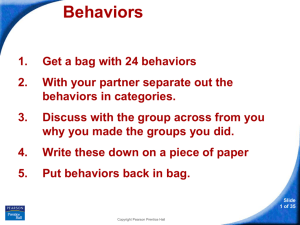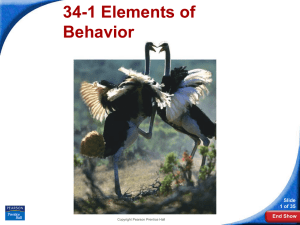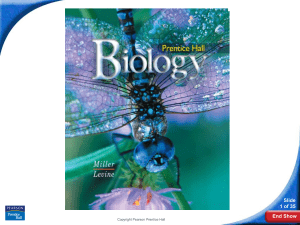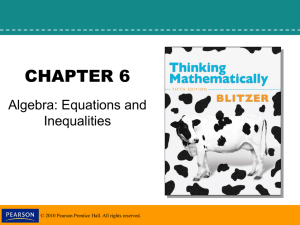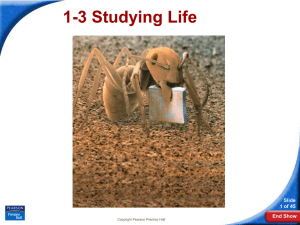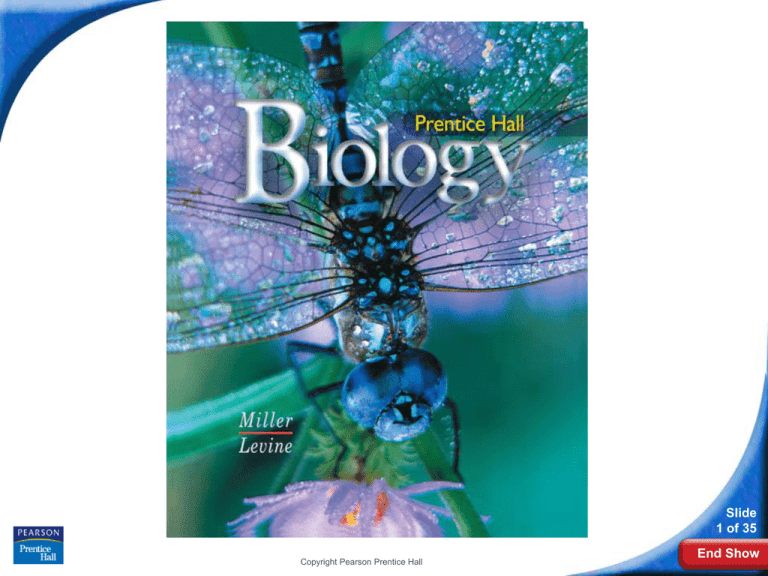
Biology
Slide
1 of 35
Copyright Pearson Prentice Hall
End Show
34-1 Elements of
Behavior
Slide
2 of 35
Copyright Pearson Prentice Hall
End Show
34-1 Elements of Behavior
Stimulus and Response
Stimulus and Response
Biologists define behavior as the way an organism
reacts to changes in its internal condition or
external environment.
A behavior can be simple or complex.
Slide
3 of 35
Copyright Pearson Prentice Hall
End Show
34-1 Elements of Behavior
Stimulus and Response
Behaviors are performed when an animal reacts to a
stimulus.
A stimulus is any kind of signal that carries
information and can be detected.
For example, hunger is an internal stimulus that may
prompt you to eat. The sound of a ringing phone is a
stimulus that may prompt you to answer the phone.
Slide
4 of 35
Copyright Pearson Prentice Hall
End Show
34-1 Elements of Behavior
Stimulus and Response
A single, specific reaction to a stimulus is called a
response.
A behavior may consist of more than one response.
For example, a shark may respond to the movement
of prey by swimming toward the prey and attacking it.
Slide
5 of 35
Copyright Pearson Prentice Hall
End Show
34-1 Elements of Behavior
Stimulus and Response
Types of Stimuli
Animals respond to many types of stimuli, such as
light, sound, odors, and heat.
Slide
6 of 35
Copyright Pearson Prentice Hall
End Show
34-1 Elements of Behavior
Stimulus and Response
What produces behavior in animals?
Slide
7 of 35
Copyright Pearson Prentice Hall
End Show
34-1 Elements of Behavior
Stimulus and Response
How Animals Respond
When an animal responds to a stimulus,
its body systems—including the sense
organs, nervous system, and muscles—
interact to produce the resultant
behavior.
Slide
8 of 35
Copyright Pearson Prentice Hall
End Show
34-1 Elements of Behavior
Stimulus and Response
Once the senses detect an external stimulus,
information is passed along nerve cells to the brain.
The brain and nervous system process the
information, and direct the response.
Animals with simple nervous systems have simple
behaviors.
Animals with complex nervous systems have more
complicated and precise behaviors.
Slide
9 of 35
Copyright Pearson Prentice Hall
End Show
34-1 Elements of Behavior
Behavior and Evolution
Behavior and Evolution
Animal behavior is important to survival and
reproduction.
Many behaviors are influenced by genes and can
be inherited.
Slide
10 of 35
Copyright Pearson Prentice Hall
End Show
34-1 Elements of Behavior
Behavior and Evolution
Behaviors may evolve under the influence of natural
selection.
Organisms with an adaptive behavior will survive and
reproduce better than organisms that lack the
behavior.
After natural selection has operated for many
generations, most individuals will exhibit the adaptive
behavior.
Slide
11 of 35
Copyright Pearson Prentice Hall
End Show
34-1 Elements of Behavior
Innate Behavior
What is an innate behavior?
Slide
12 of 35
Copyright Pearson Prentice Hall
End Show
34-1 Elements of Behavior
Innate Behavior
Innate Behavior
An innate behavior is an instinct, or inborn
behavior.
Innate behaviors appear in fully
functional form the first time they are
performed, even though the animal may
have had no previous experience with the
stimuli to which it responds.
Slide
13 of 35
Copyright Pearson Prentice Hall
End Show
34-1 Elements of Behavior
Innate Behavior
Examples of innate behavior:
• the suckling of a newborn mammal
• the weaving of a spider web
Slide
14 of 35
Copyright Pearson Prentice Hall
End Show
34-1 Elements of Behavior
Innate Behavior
Innate behaviors depend on internal mechanisms
that develop from complex interactions between an
animal's genes and its environment.
Slide
15 of 35
Copyright Pearson Prentice Hall
End Show
34-1 Elements of Behavior
Learned Behavior
What are the major types of learning?
Slide
16 of 35
Copyright Pearson Prentice Hall
End Show
34-1 Elements of Behavior
Learned Behavior
Learned Behavior
Many animals can alter their behavior based on
experience. A change in behavior that results from
experience is called learning.
Learning is also called acquired behavior.
Slide
17 of 35
Copyright Pearson Prentice Hall
End Show
34-1 Elements of Behavior
Learned Behavior
The four major types of learning are:
• habituation
• classical conditioning
• operant conditioning
• insight learning
Slide
18 of 35
Copyright Pearson Prentice Hall
End Show
34-1 Elements of Behavior
Learned Behavior
Habituation
Habituation is a process by which an animal
decreases or stops its response to a repetitive
stimulus that neither rewards nor harms it.
For example, a worm may stop responding to the
shadow of something that neither provides the
worm with food nor threatens it.
By ignoring a nonthreatening or unrewarding
stimulus, animals can spend their time and energy
more efficiently.
Slide
19 of 35
Copyright Pearson Prentice Hall
End Show
34-1 Elements of Behavior
Learned Behavior
Classical Conditioning
Any time an animal makes a mental connection
between a stimulus and some kind of reward or
punishment, it has learned by classical
conditioning.
An example of classical conditioning is the work of
Pavlov and his dog. (Pavlov's experiment is shown
on the next few slides.)
Slide
20 of 35
Copyright Pearson Prentice Hall
End Show
34-1 Elements of Behavior
Learned Behavior
1. Before Conditioning
When a dog sees or
smells food, it produces
saliva.
Food is the stimulus and
the dog’s response is
salivation.
Dogs do not usually
salivate in response to
nonfood stimuli.
Slide
21 of 35
Copyright Pearson Prentice Hall
End Show
34-1 Elements of Behavior
Learned Behavior
2. During Conditioning
By ringing a bell every
time he fed the dog,
Pavlov trained the dog
to associate the sight
and smell of food with
the ringing bell.
Slide
22 of 35
Copyright Pearson Prentice Hall
End Show
34-1 Elements of Behavior
Learned Behavior
3. After Conditioning
When Pavlov rang a bell
in the absence of food,
the dog still salivated.
The dog was conditioned
to salivate in response to
a stimulus that it did not
normally associate with
food.
Slide
23 of 35
Copyright Pearson Prentice Hall
End Show
34-1 Elements of Behavior
Learned Behavior
Operant Conditioning
Operant conditioning occurs when an animal
learns to behave in a certain way through repeated
practice, in order to receive a reward or avoid
punishment.
Operant conditioning is also called trial-and-error
learning.
Slide
24 of 35
Copyright Pearson Prentice Hall
End Show
34-1 Elements of Behavior
Learned Behavior
Operant conditioning was first described by B. F.
Skinner.
Skinner invented a testing procedure using a
“Skinner box.”
A Skinner box has a colored button that, when
pressed, delivers a food reward.
After an animal is rewarded several times, it learns
that it gets food whenever it presses the button.
Slide
25 of 35
Copyright Pearson Prentice Hall
End Show
34-1 Elements of Behavior
Learned Behavior
Insight Learning
Insight learning, or reasoning, occurs when an
animal applies something it has already learned to
a new situation, without a period of trial and error.
Insight learning is common among humans and
primates.
If you are given a math problem on an exam, you
use insight learning in order to solve it.
Slide
26 of 35
Copyright Pearson Prentice Hall
End Show
34-1 Elements of Behavior
Instinct and Learning Combined
Instinct and Learning Combined
Most behaviors are a combination of instinct and
learning.
Young white-crowned sparrows have an innate
ability to recognize their own species’ song. To sing
the complete version, the young birds must first
hear it sung by adults.
Slide
27 of 35
Copyright Pearson Prentice Hall
End Show
34-1 Elements of Behavior
Instinct and Learning Combined
Some young animals learn to recognize and follow
the first moving object they see during an early time
in their lives. This process is called imprinting.
Imprinting keeps young animals close to their mother,
who protects them and leads them to food.
Once imprinting occurs, the behavior cannot be
changed.
Slide
28 of 35
Copyright Pearson Prentice Hall
End Show
34-1 Elements of Behavior
Instinct and Learning Combined
Imprinting can occur through scent as well as sight.
Salmon imprint on the odor of the stream in which
they hatch. When they are mature, salmon remember
the odor of the stream and return there to spawn.
Slide
29 of 35
Copyright Pearson Prentice Hall
End Show
34-1
Click to Launch:
Continue to:
- or -
Slide
30 of 35
End Show
Copyright Pearson Prentice Hall
34-1
Change in an animal's behavior as a result of
experience is called
a. stimulus.
b. learning.
c. response.
d. reflex.
Slide
31 of 35
End Show
Copyright Pearson Prentice Hall
34-1
When a spider builds a web, it displays
a. learned behavior.
b. innate behavior.
c. habituation.
d. insight learning.
Slide
32 of 35
End Show
Copyright Pearson Prentice Hall
34-1
Ivan Pavlov's training of a dog to salivate in
response to a ringing bell is known as
a. habituation.
b. imprinting.
c. classical conditioning.
d. stimulus.
Slide
33 of 35
End Show
Copyright Pearson Prentice Hall
34-1
The process in which young animals learn to
recognize and follow the first moving object they
see is called
a. insight learning.
b. habituation.
c. imprinting.
d. classical conditioning.
Slide
34 of 35
End Show
Copyright Pearson Prentice Hall
34-1
Habituation helps animals survive because it
a. helps animals find food.
b. enables animals to escape predators.
c. enables animals to recognize members of
their own species.
d. helps animals avoid wasting time and energy.
Slide
35 of 35
End Show
Copyright Pearson Prentice Hall
END OF SECTION

